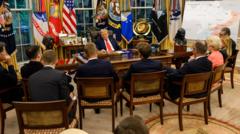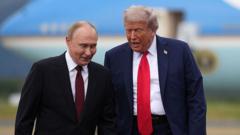How Did the Oval Office Map Shape Trump's Perspective on the Ukraine War?

Understanding the Current Landscape of the Ukraine Conflict
The ongoing conflict in Ukraine continues to be a focal point for international political discussions, particularly with the significant territorial losses suffered by Ukraine since the onset of hostilities in 2014. The situation has evolved into a complex battlefield characterized by shifting lines and ongoing debates regarding territorial integrity and compromises with Russia. In recent conversations between Ukrainian President Volodymyr Zelensky and former U.S. President Donald Trump, maps depicting the current state of territorial control have taken center stage, illustrating the stark realities on the ground.
The Significance of Maps in Diplomatic Discussions
Maps serve as powerful visual aids in diplomacy, encapsulating the realities of territorial control and influencing negotiations. During a meeting in the Oval Office, a prominent map shaded in red emphasized the areas occupied by Russian forces, which now reportedly encompass nearly a fifth of Ukraine's territory. Trump’s reference to this map during an interview underscored the perception that significant portions of land have been permanently lost to Russian control. This visual representation of the conflict has become a pivotal element in shaping discussions about possible territorial compromises and land swaps with Russia.
Territorial Control: The Reality of the Situation
As highlighted in the discussions between Zelensky and Trump, the reality of territorial control in Ukraine is dire. The Donbas region, which is critical both economically and strategically, has been under heavy Russian influence, with estimates indicating that approximately 79% of Donbas is now controlled by Russia. This has led to a challenging environment for Ukraine, as they grapple with the implications of these territorial losses and the potential need to negotiate with an aggressor.
Economic Implications of the Conflict
The Donbas region, prior to the conflict, contributed around 16% to Ukraine's overall economic output, emphasizing its importance not only in terms of territory but also in economic stability. The loss of such a significant portion of land poses serious challenges for Ukraine’s economy, affecting industries like mining and manufacturing that thrive in this area. As the war continues, the economic ramifications of losing control over these resources are likely to escalate.
Insights from Military Analysts
Military analysts have been closely monitoring the situation, providing valuable insights into the dynamics of territorial control and the potential for future developments. According to the latest assessments, Russia's military has made notable advancements in specific regions, particularly around Kupiansk in Kharkiv and Kreminna in Luhansk. However, these gains come at a cost, as the complexities of warfare in these areas present significant challenges for both sides.
The Challenges Ahead for Ukraine
Despite recent advances, Ukraine’s military leaders report that the frontline remains largely static, with limited shifts since the early months of the conflict. The challenges are compounded by a shortage of manpower and resources, making it difficult for Ukrainian forces to defend the extensive front line effectively. The use of advanced technology, including drones, has become increasingly common in Russian military tactics, which adds another layer of complexity to the conflict.
International Responses and Strategic Considerations
The international community continues to observe the situation with concern, as the implications of the conflict extend beyond Ukraine’s borders. The discussions between Trump and Zelensky highlight a divergence in perspectives regarding territorial compromises, with Trump emphasizing the need for pragmatic solutions while Zelensky remains committed to reclaiming lost territories. This difference in approach reflects broader geopolitical considerations and the potential for future negotiations.
Future of the Conflict: Possible Outcomes
As analysts consider the potential outcomes of the ongoing conflict, various scenarios emerge. One possibility is a prolonged stalemate, where neither side gains significant ground, leading to a war of attrition. Another scenario could involve a negotiated settlement, although the terms of such a deal would likely be contentious, particularly regarding territorial integrity. The prospect of land swaps, as mentioned in discussions, raises questions about the legitimacy and fairness of conceding territory to an aggressor.
Public Sentiment and National Identity
Amidst the discussions of maps and territorial control, it is essential to consider the sentiments of the Ukrainian people. The idea of surrendering territory to Russia is met with strong resistance among the population, reflecting deep-rooted national identity and pride. The ongoing conflict has galvanized a sense of unity among Ukrainians, making any talk of territorial compromise particularly sensitive.
The Role of National Leadership
The leadership of President Zelensky has been pivotal in navigating the complex landscape of the conflict. His approach to international diplomacy, coupled with a commitment to uphold Ukraine's sovereignty, resonates with citizens and allies alike. Zelensky’s ability to articulate the realities on the ground, as demonstrated in his discussions with Trump, underscores the importance of effective leadership in times of crisis.
Conclusion: The Path Forward for Ukraine
The path forward for Ukraine remains fraught with challenges, as the conflict continues to evolve. The discussions surrounding territorial control and potential compromises reflect a broader struggle for national identity and sovereignty. As the situation unfolds, it is crucial for Ukraine to maintain its resilience and leverage international support to navigate the complexities of the ongoing conflict. While the maps may tell a story of loss, the spirit of the Ukrainian people and their commitment to reclaiming their territory remains strong.
FAQs about the Ukraine Conflict
What areas are currently controlled by Russia in Ukraine?
As of now, significant portions of the Donbas region, including areas in Luhansk and Donetsk, are under Russian control. Estimates indicate that approximately 79% of Donbas is occupied by Russian forces.
How has the conflict impacted Ukraine's economy?
The loss of territory, particularly in economically vital regions like Donbas, has severely impacted Ukraine’s economic output and stability, affecting key industries such as mining.
What are the implications of territorial compromises in the conflict?
Territorial compromises could have significant implications for Ukraine's sovereignty and national identity. The prospect of land swaps raises questions about legitimizing aggression and the long-term effects on regional stability.
As the situation in Ukraine continues to unfold, how do you think the international community should respond to the ongoing conflict? #UkraineConflict #TerritorialIntegrity #Diplomacy
```Published: 2025-08-19 18:00:44 | Category: world



